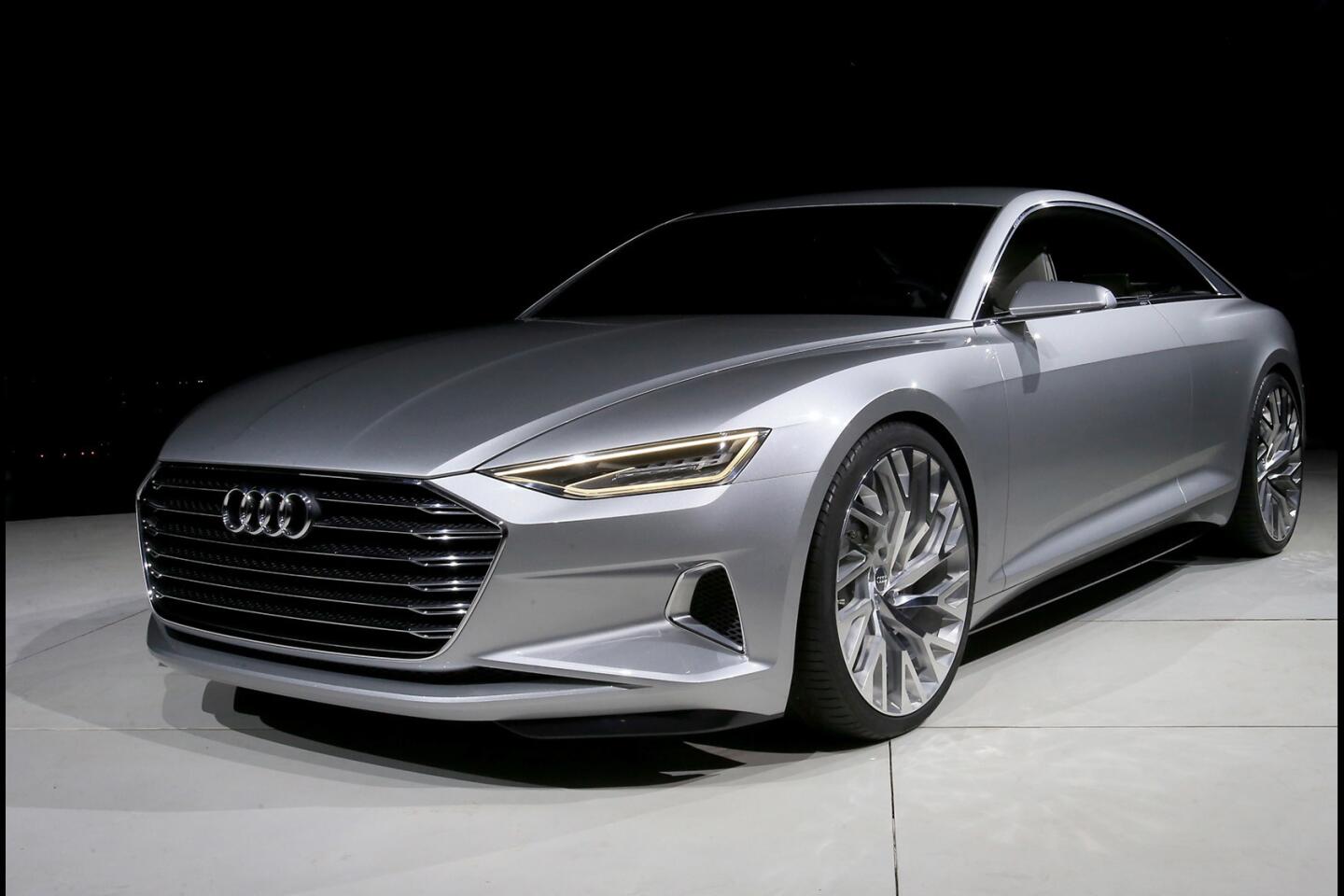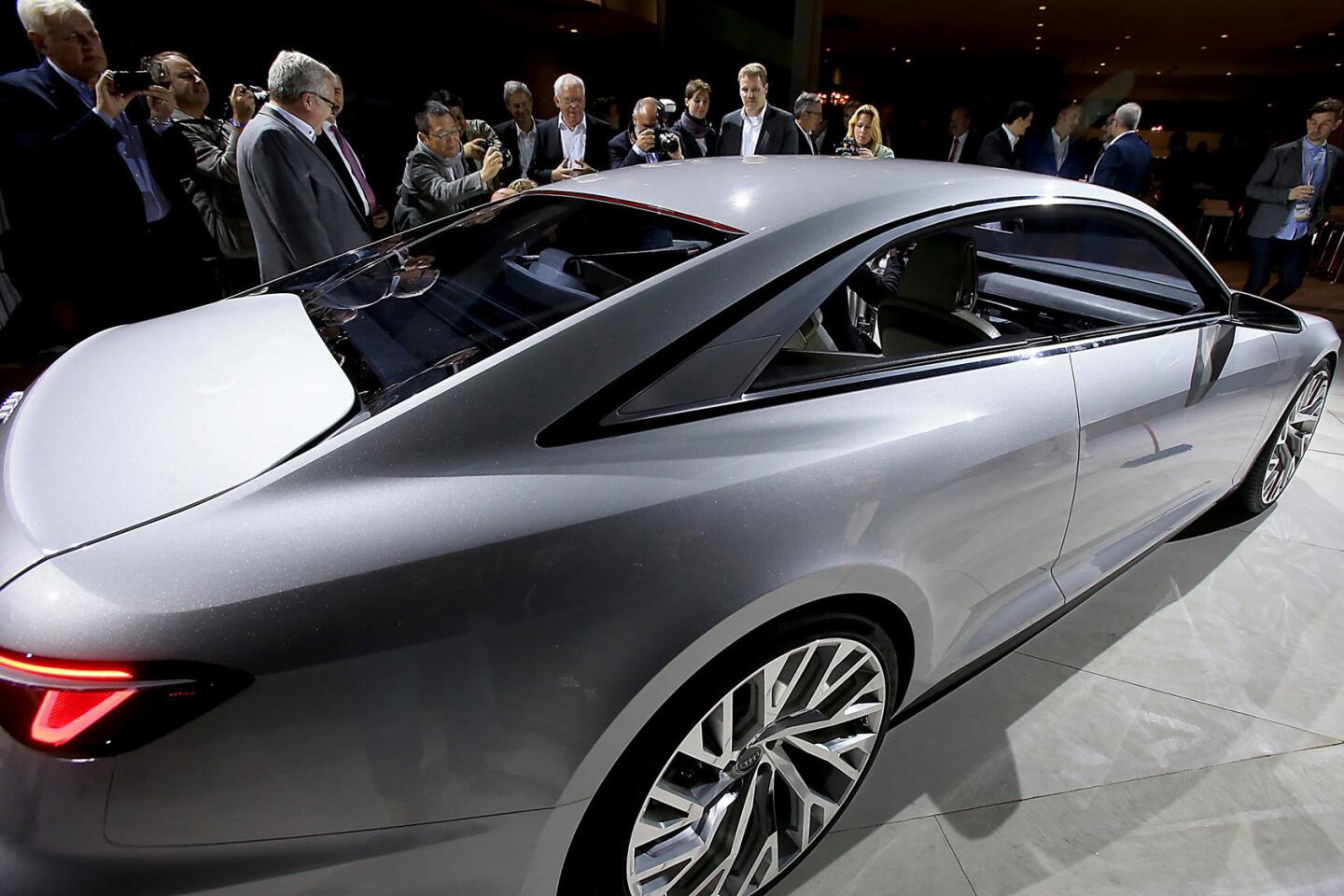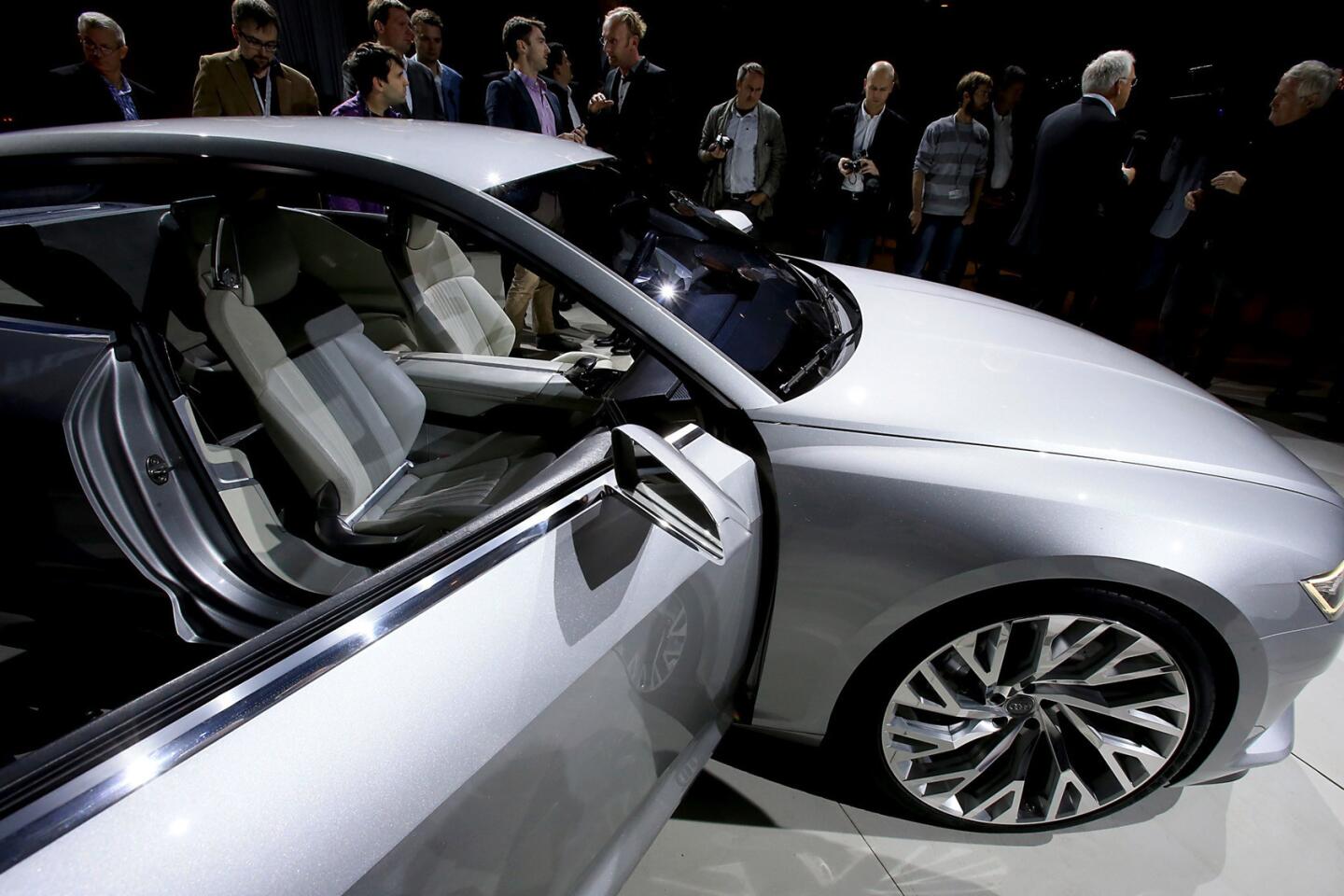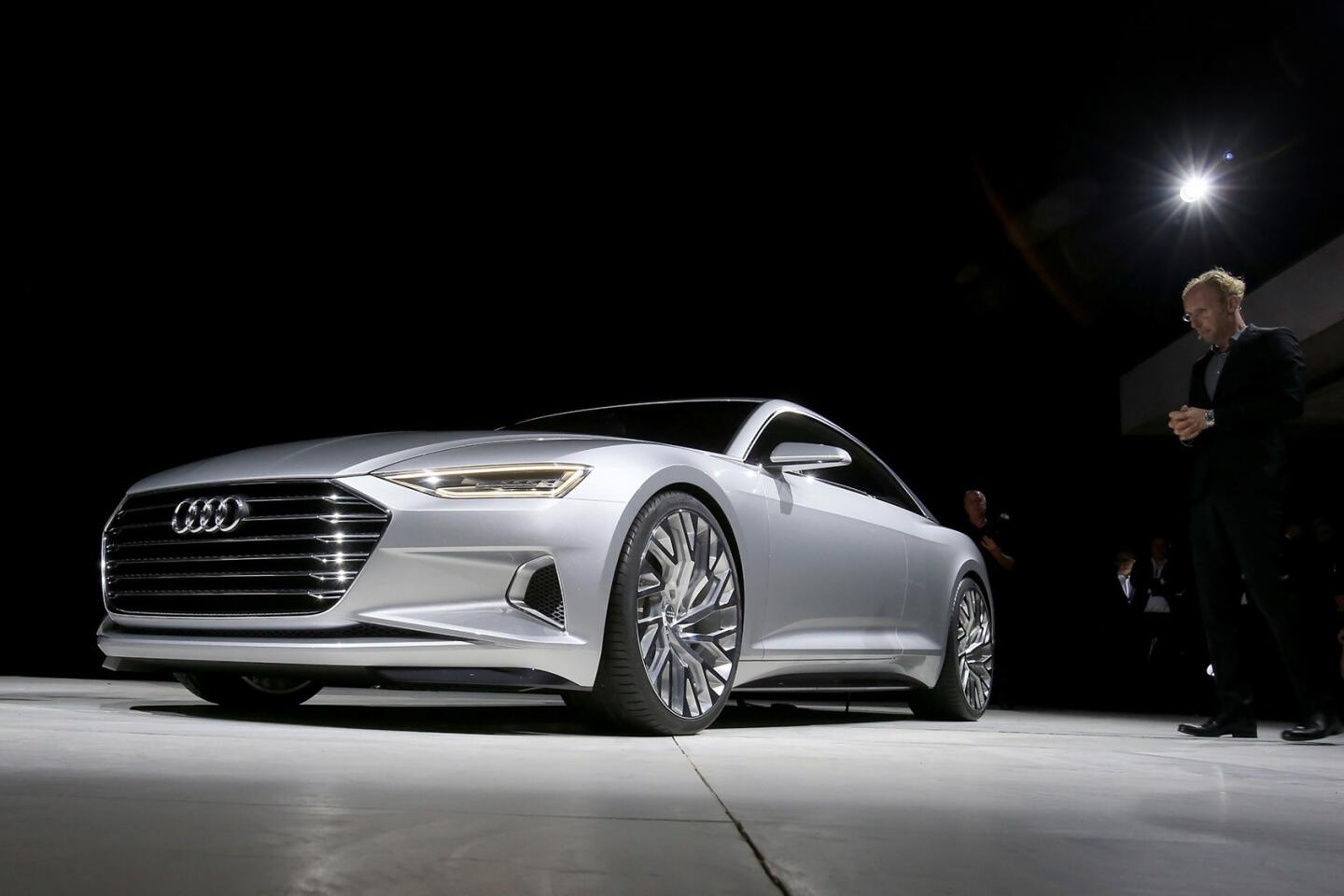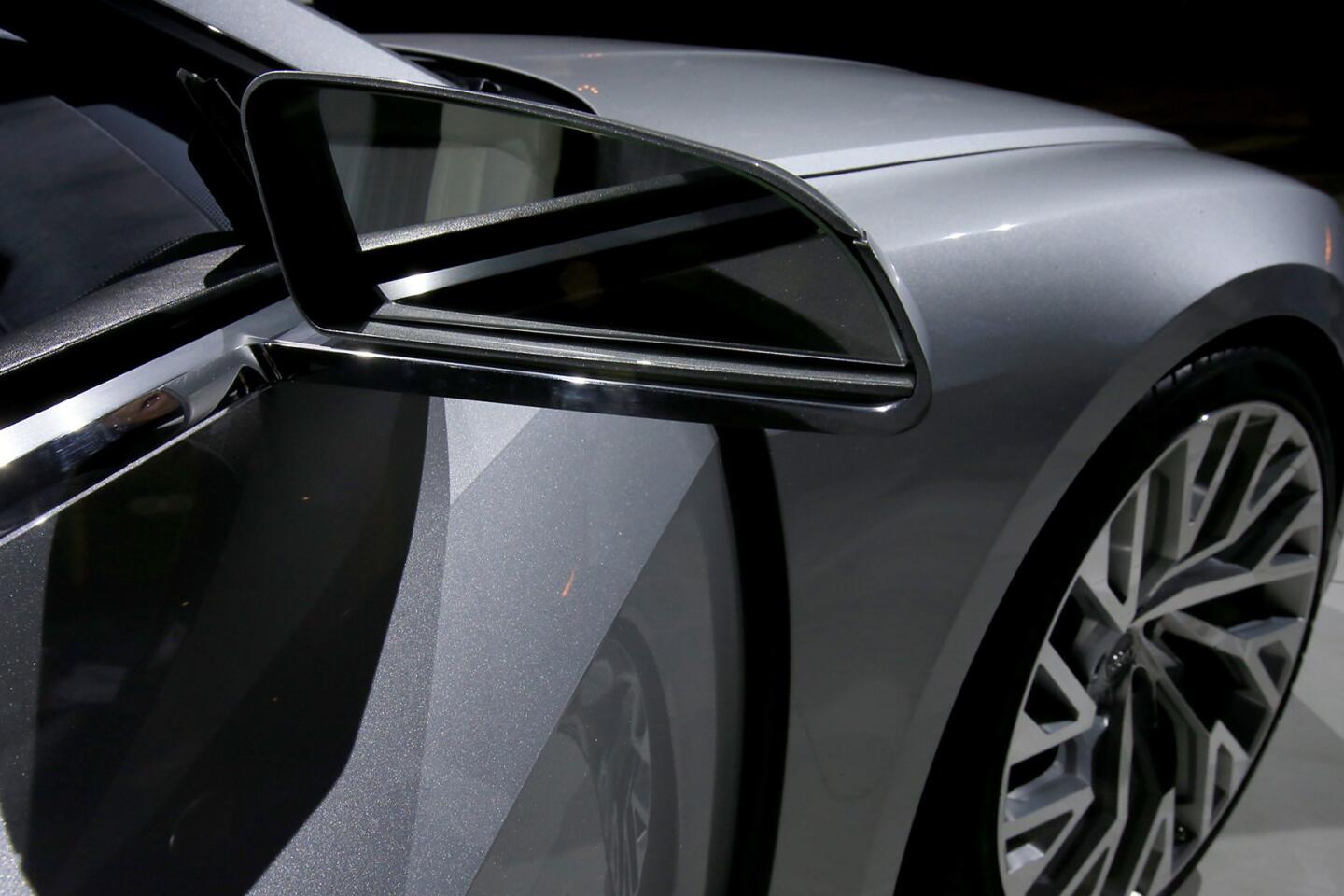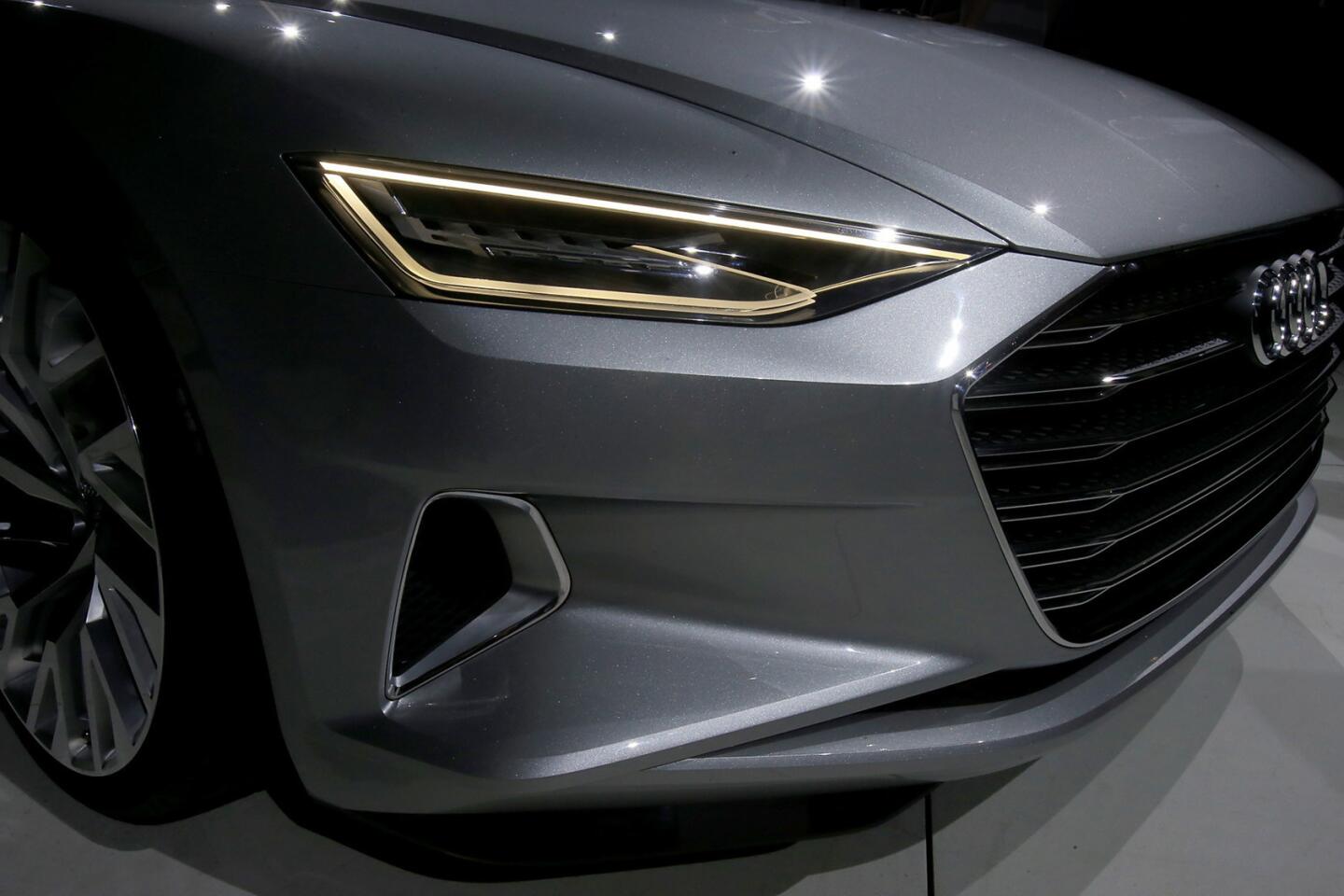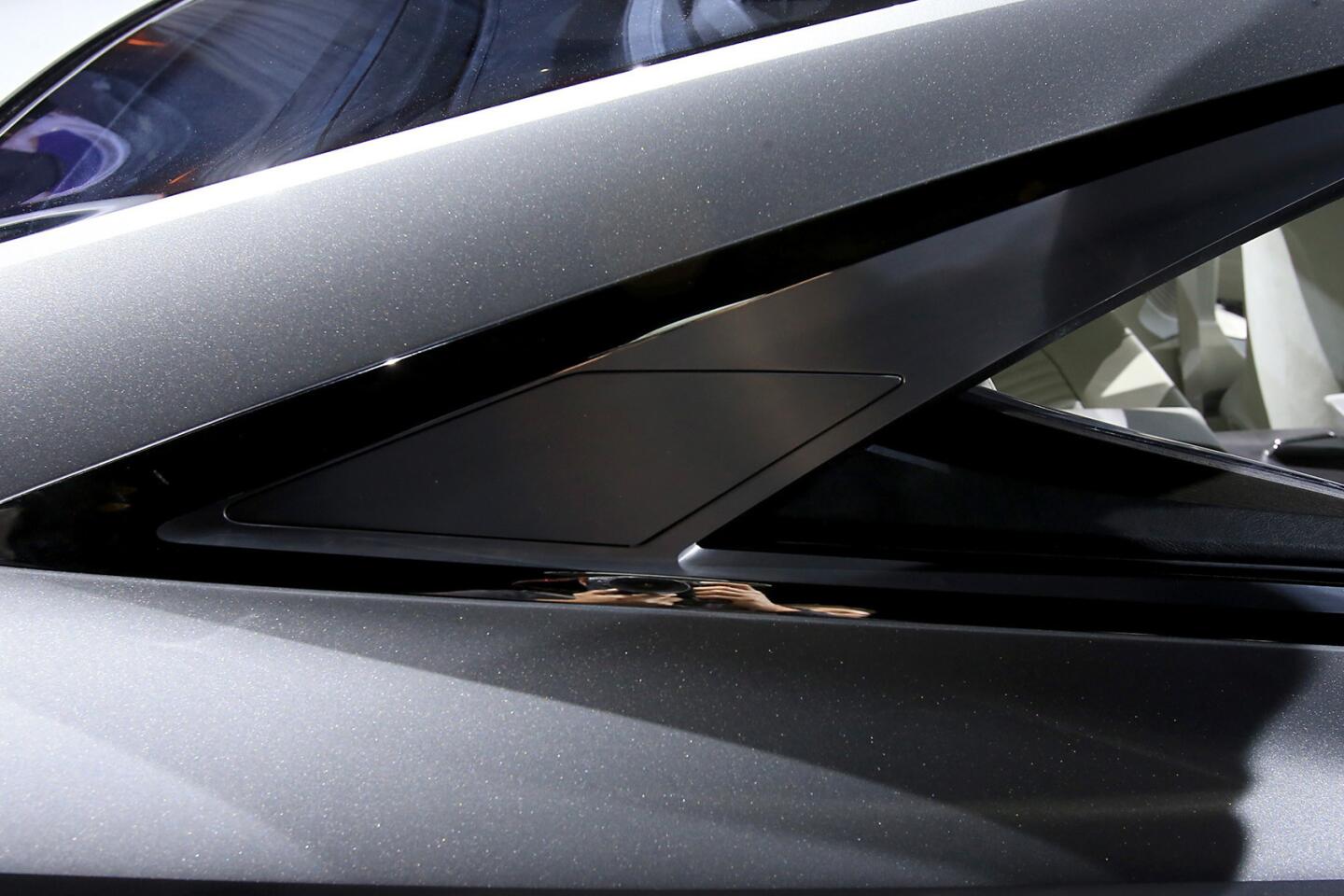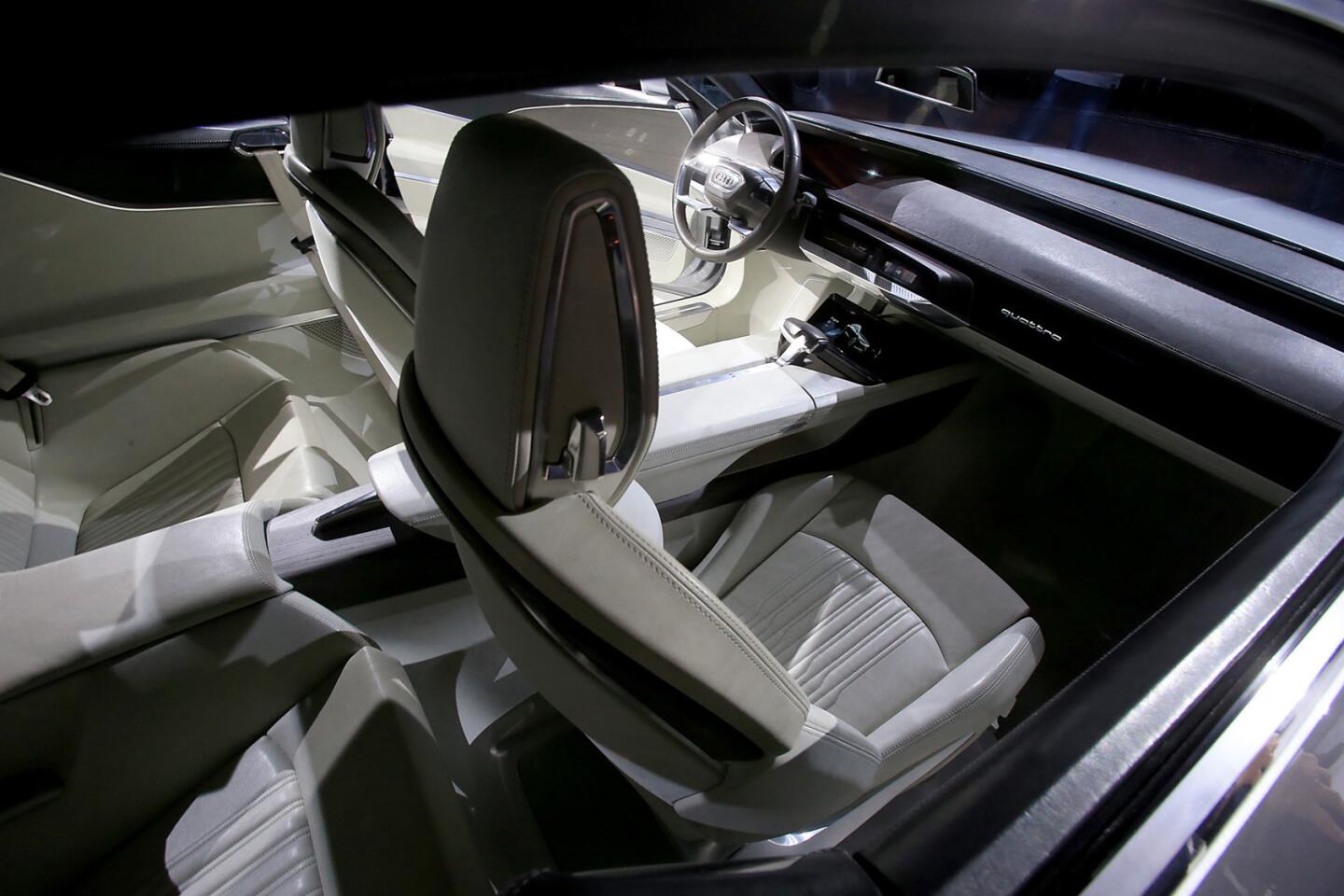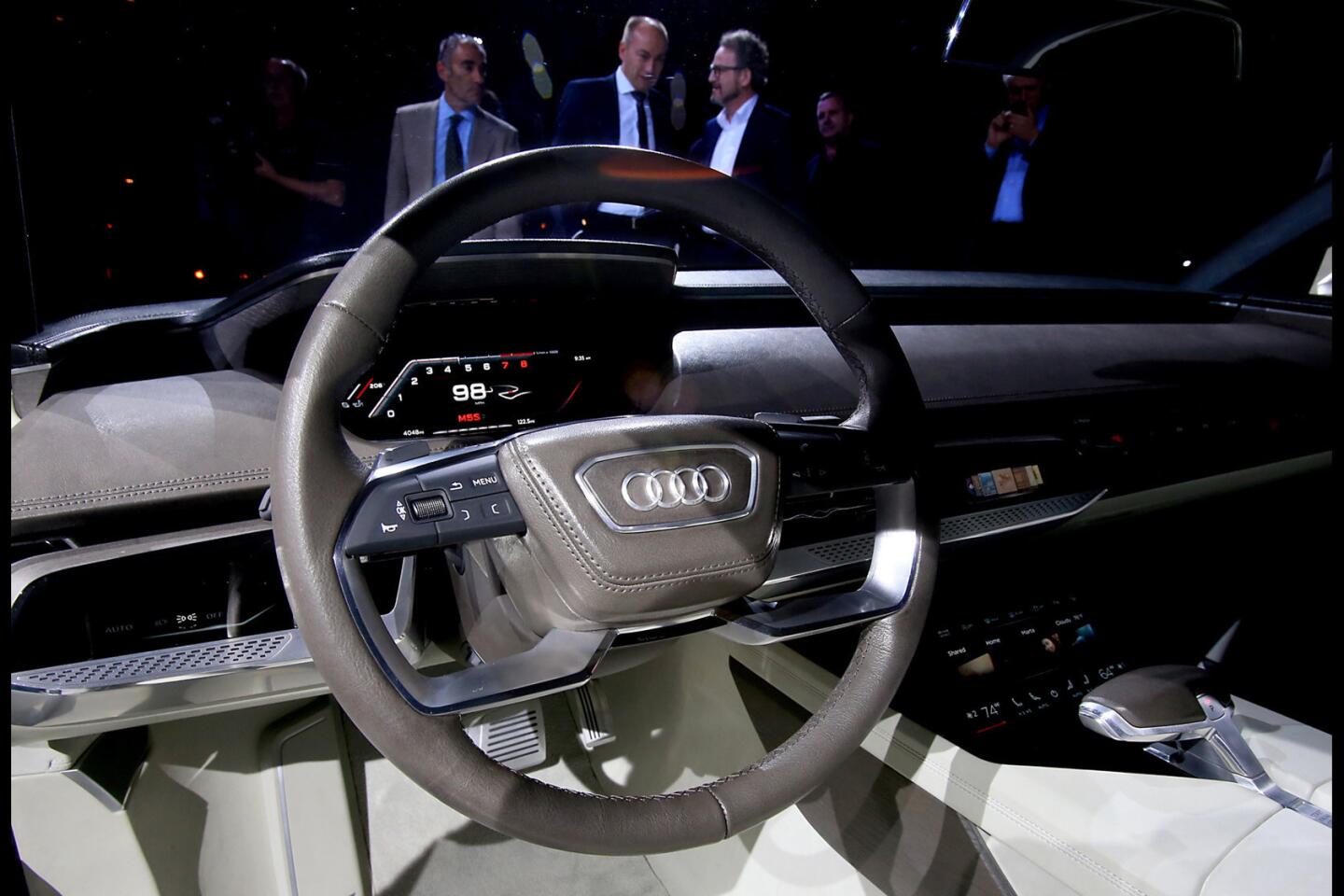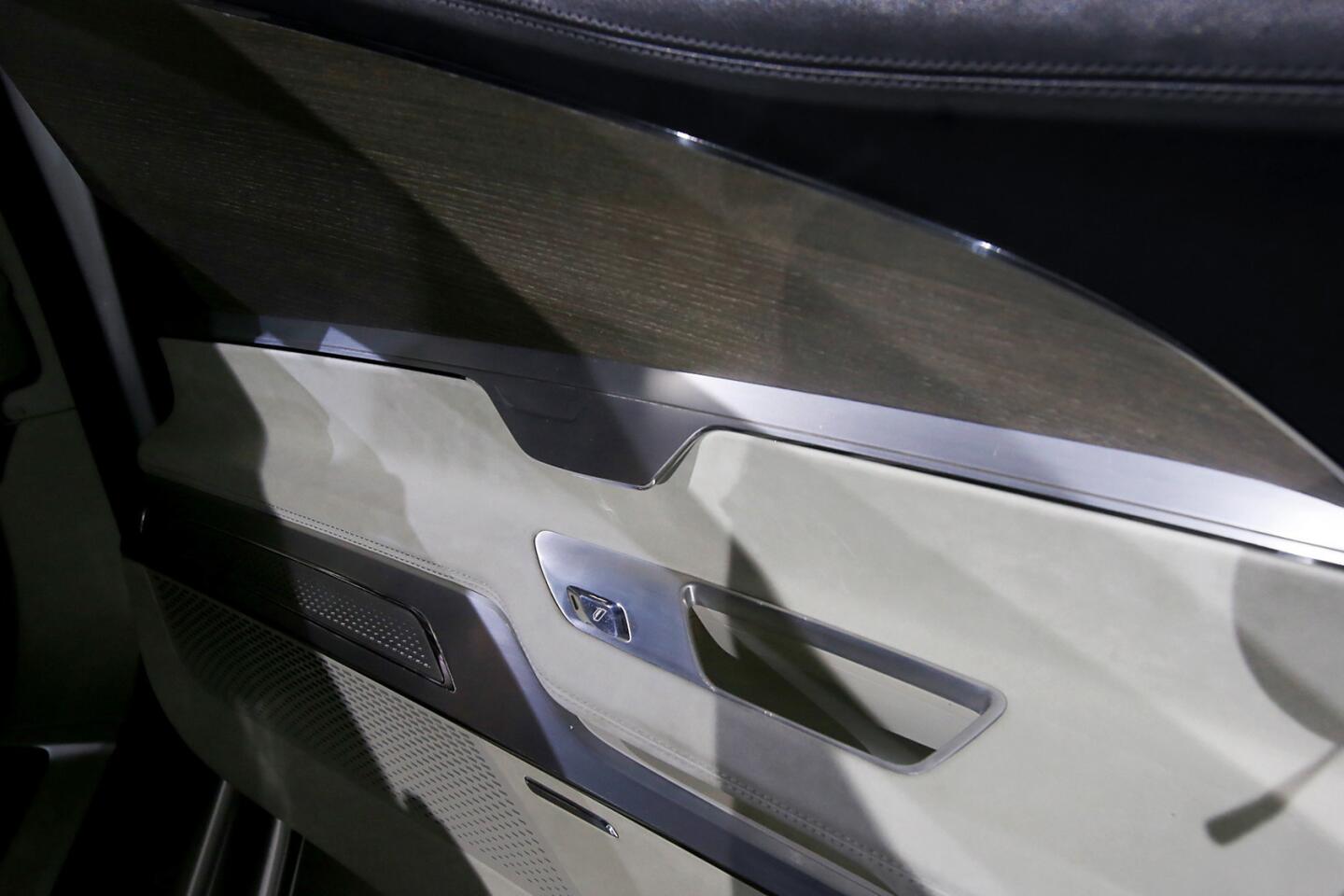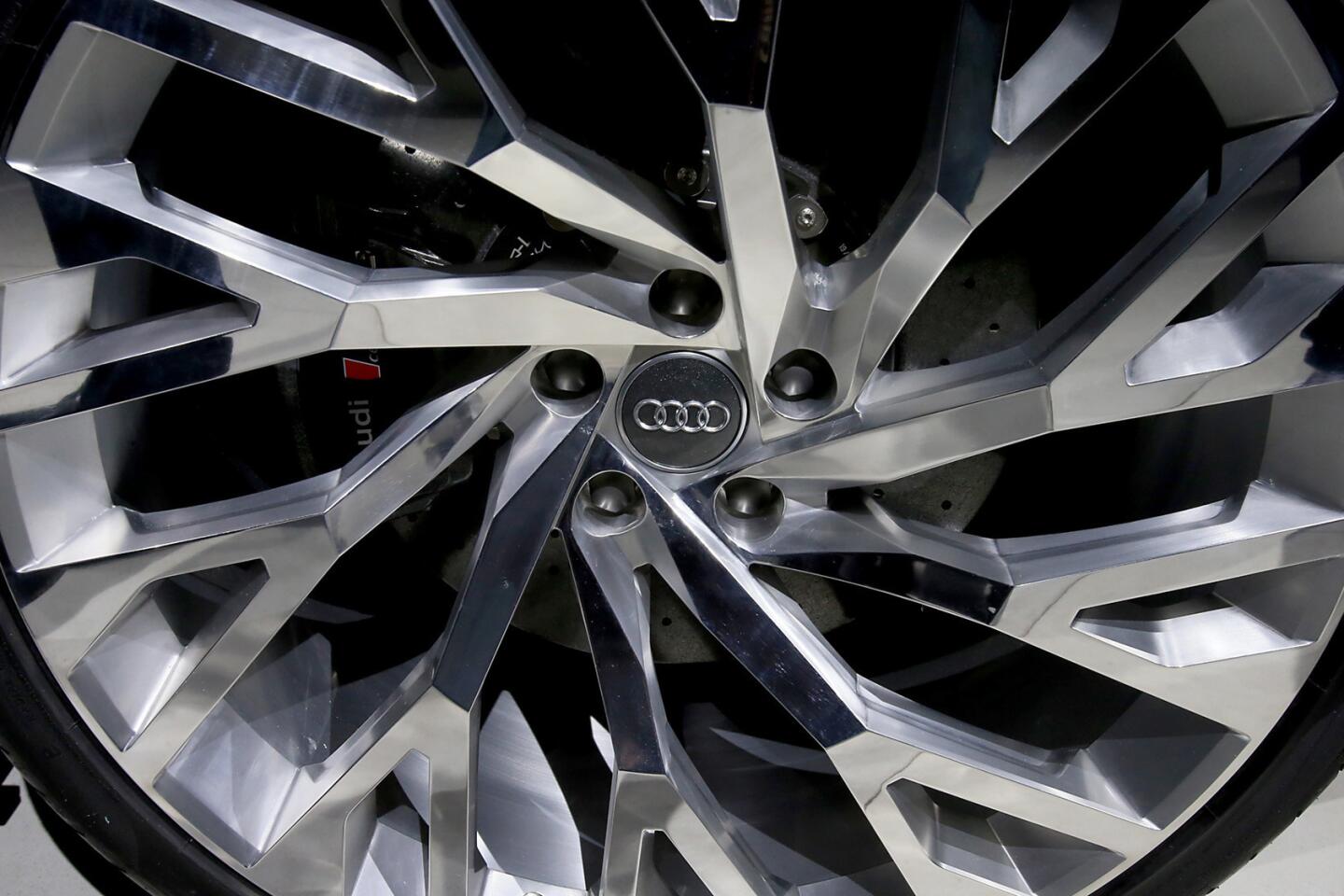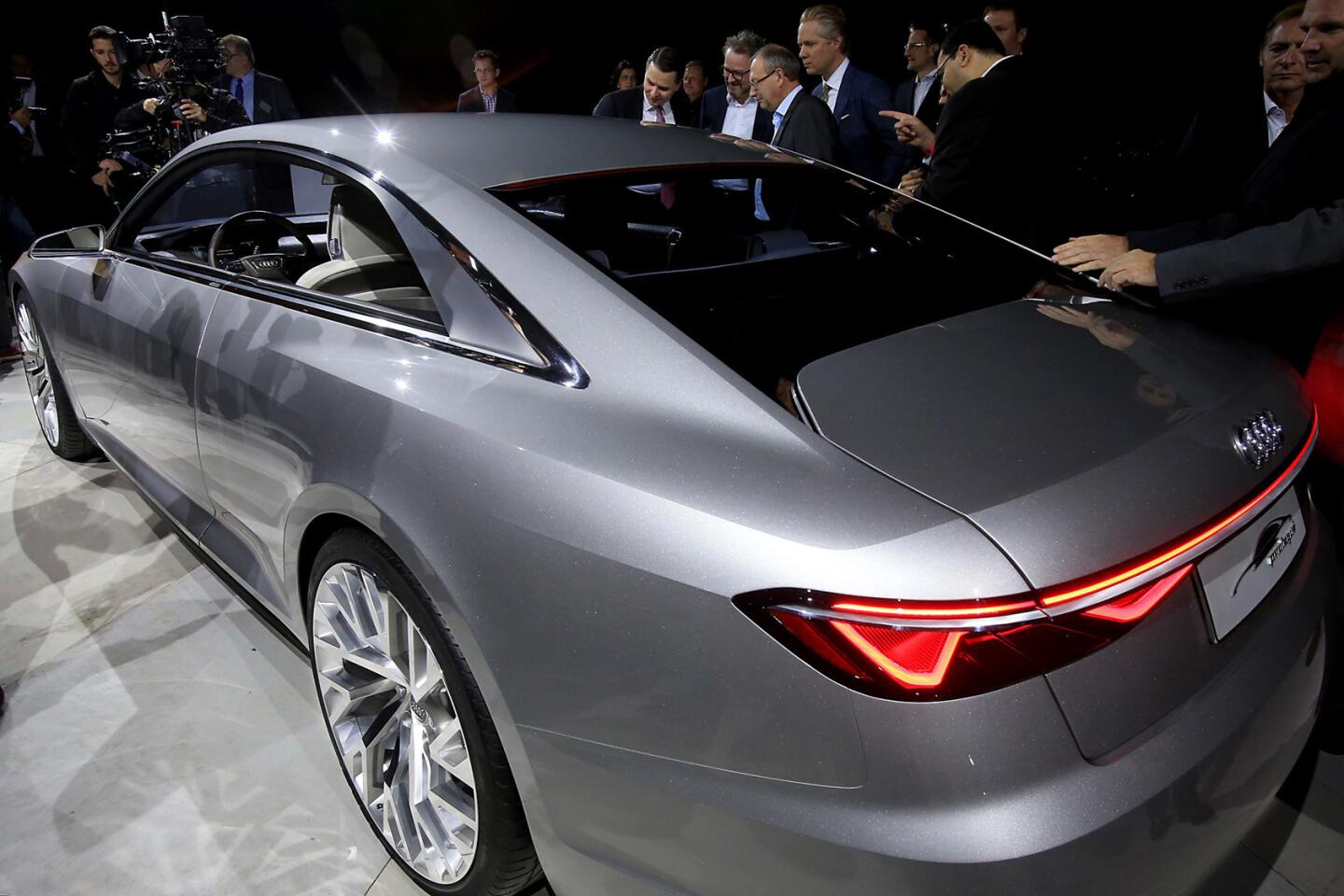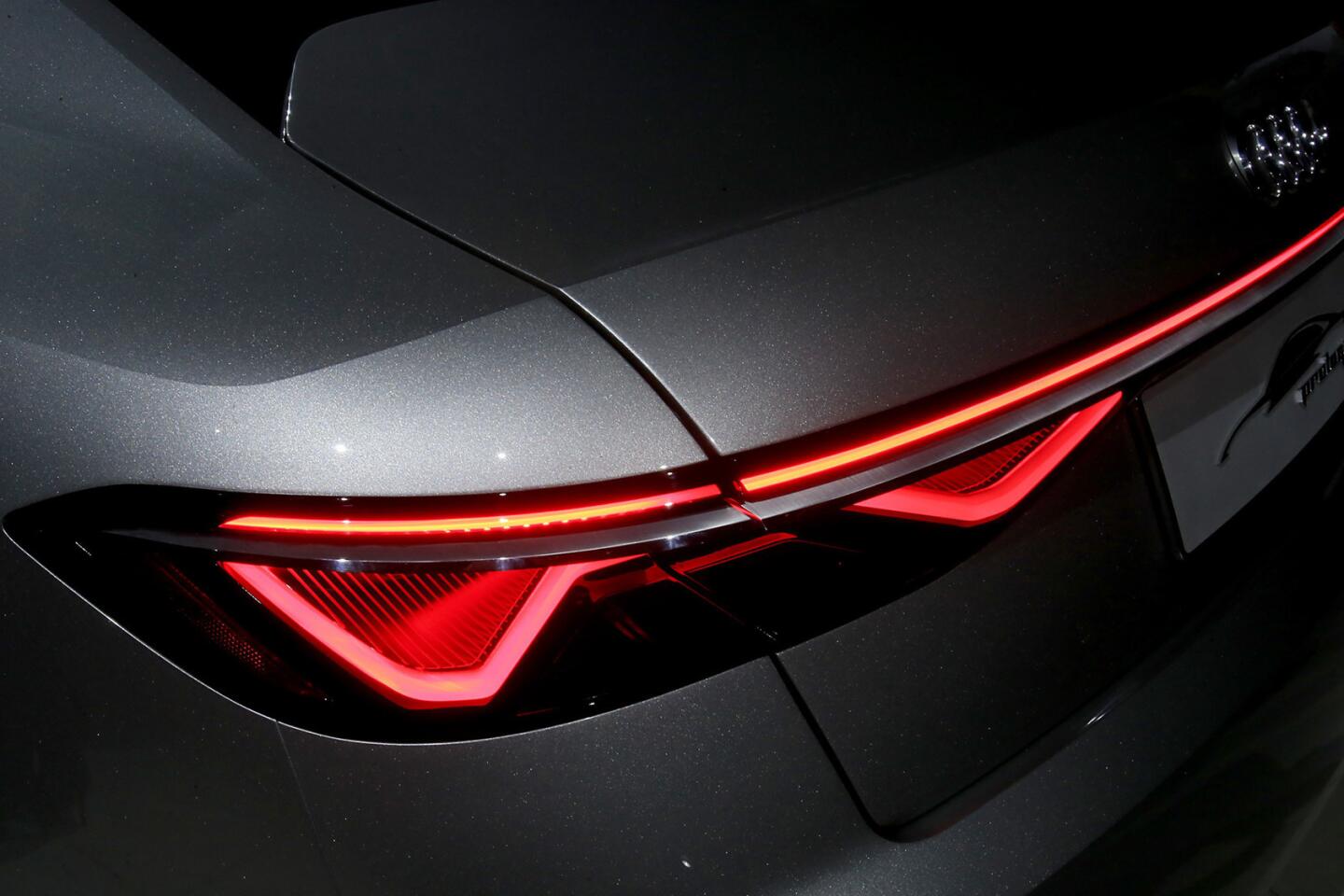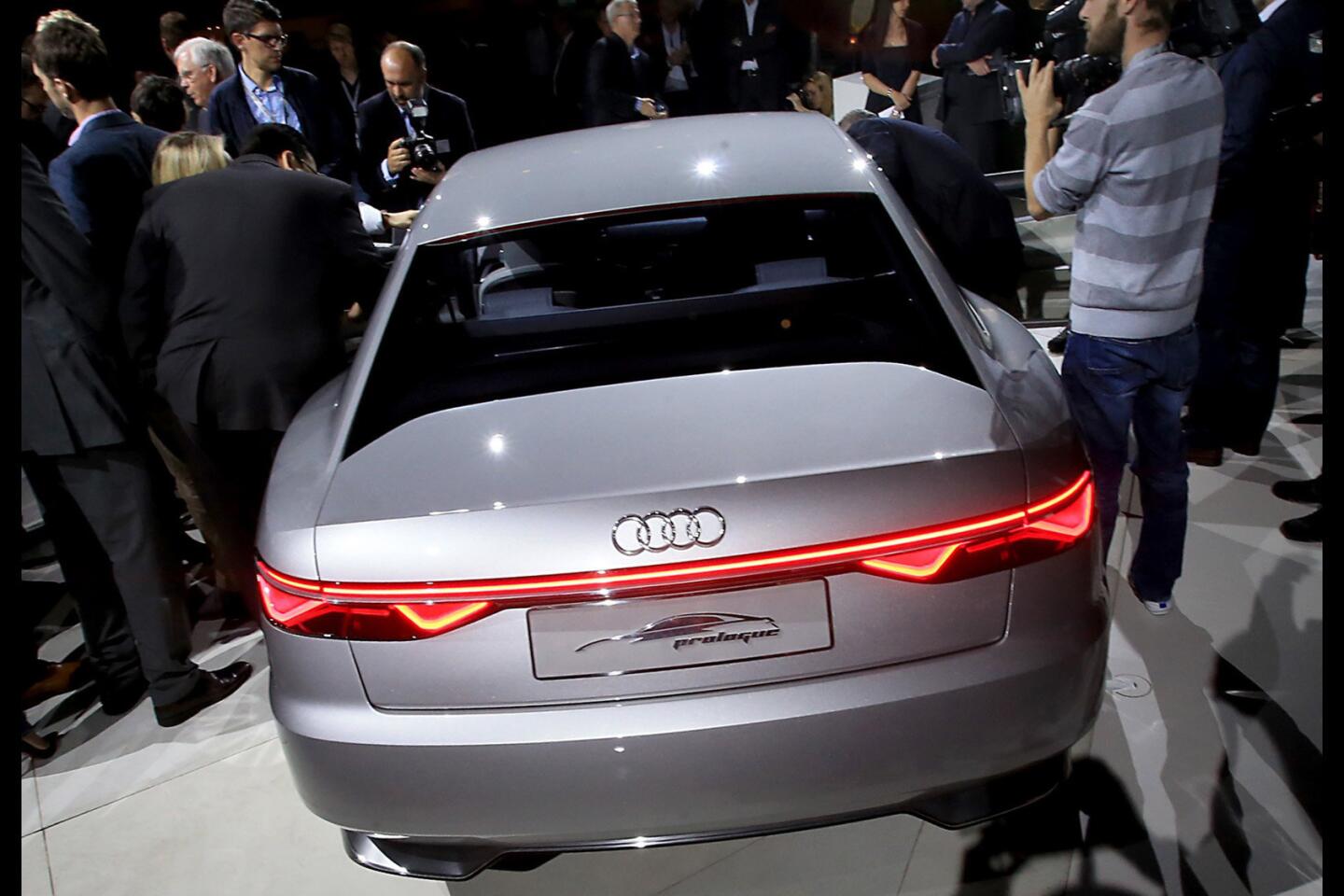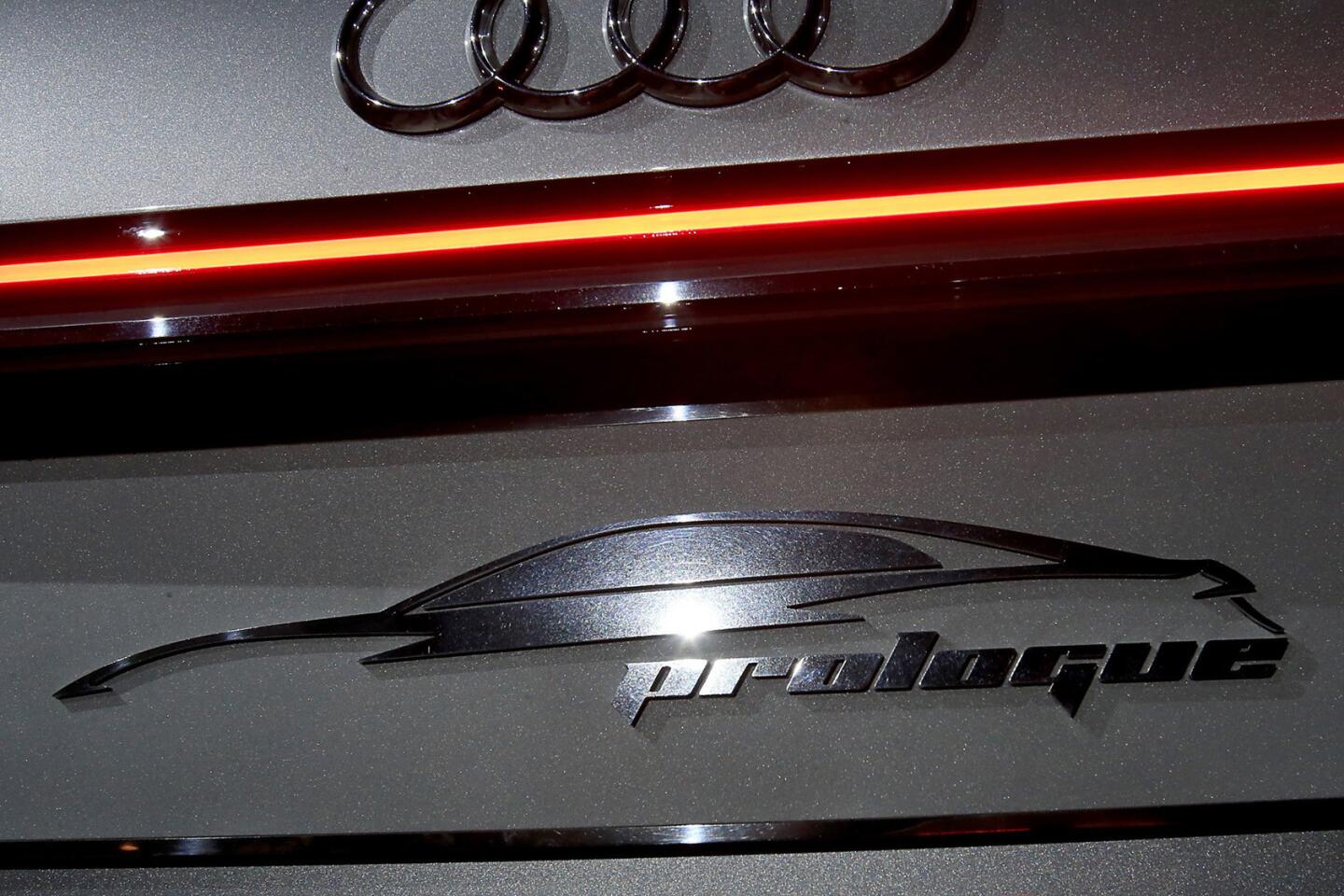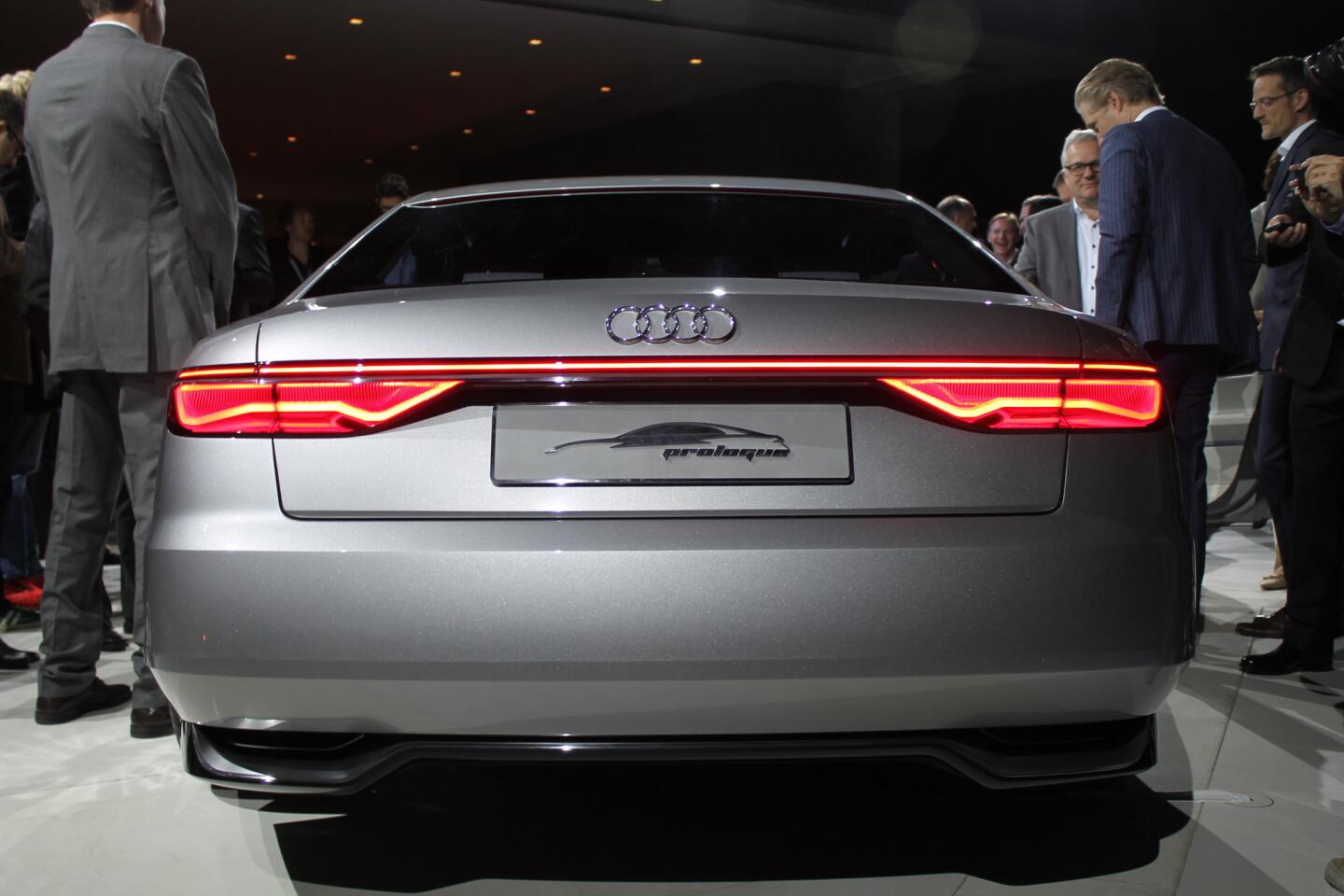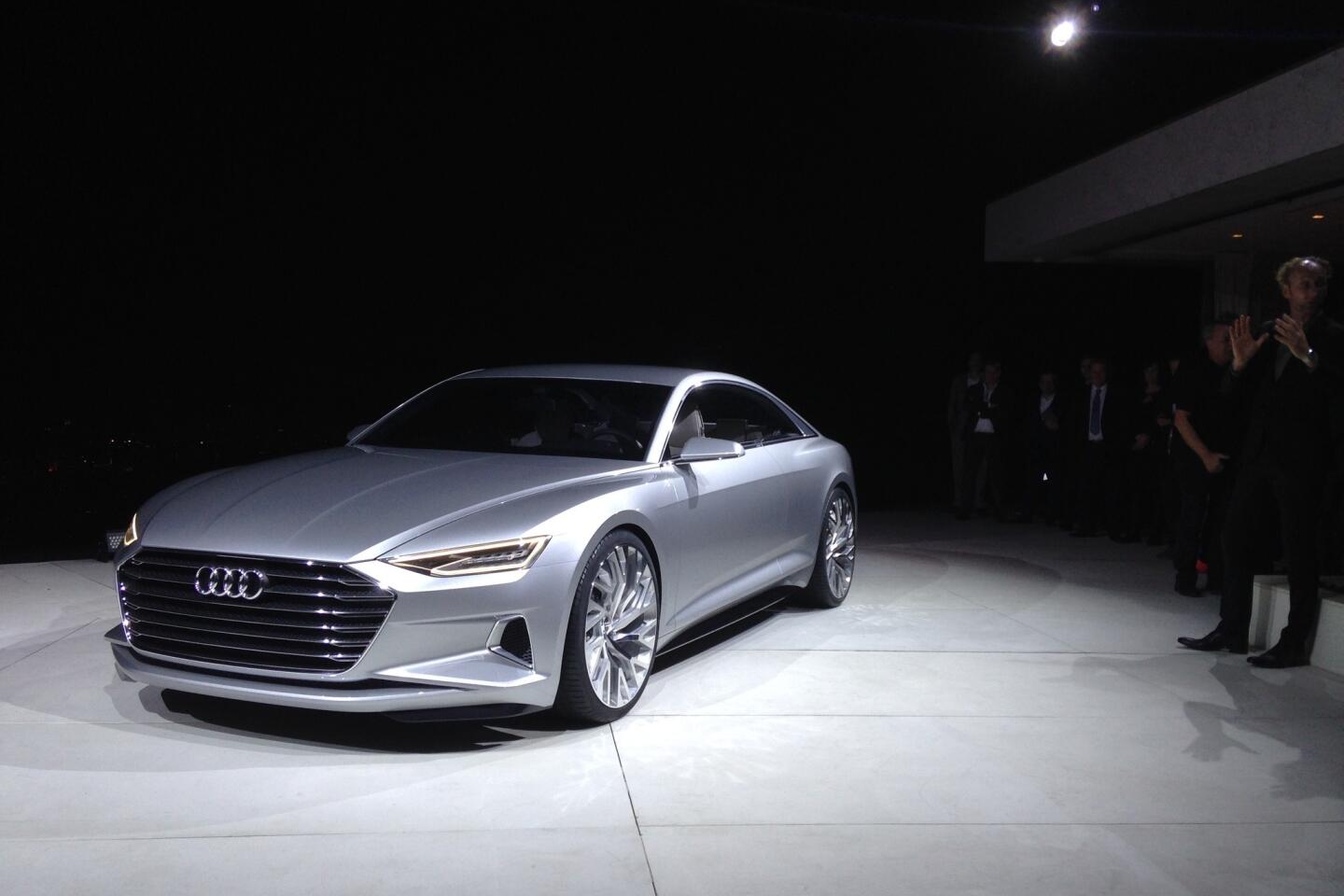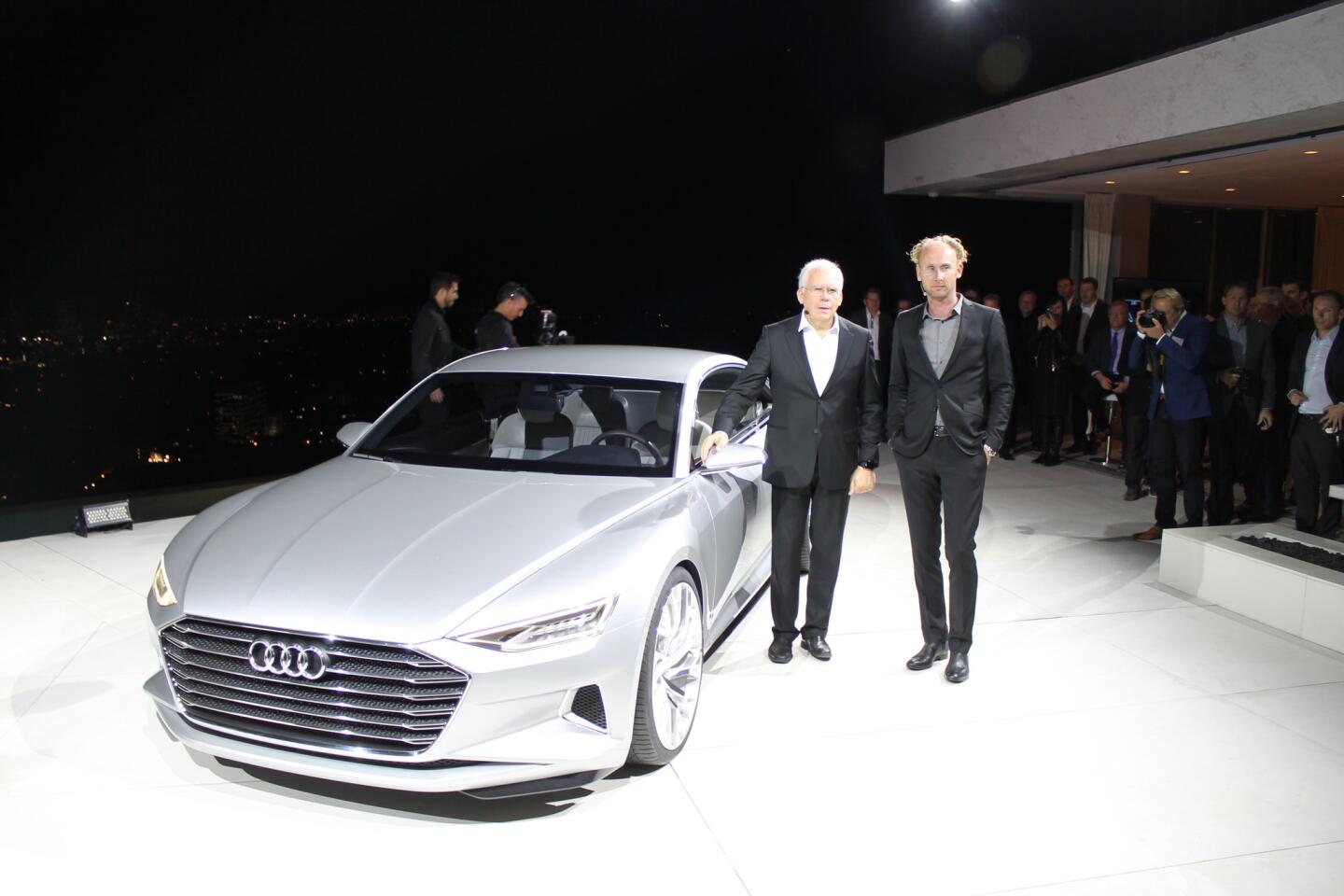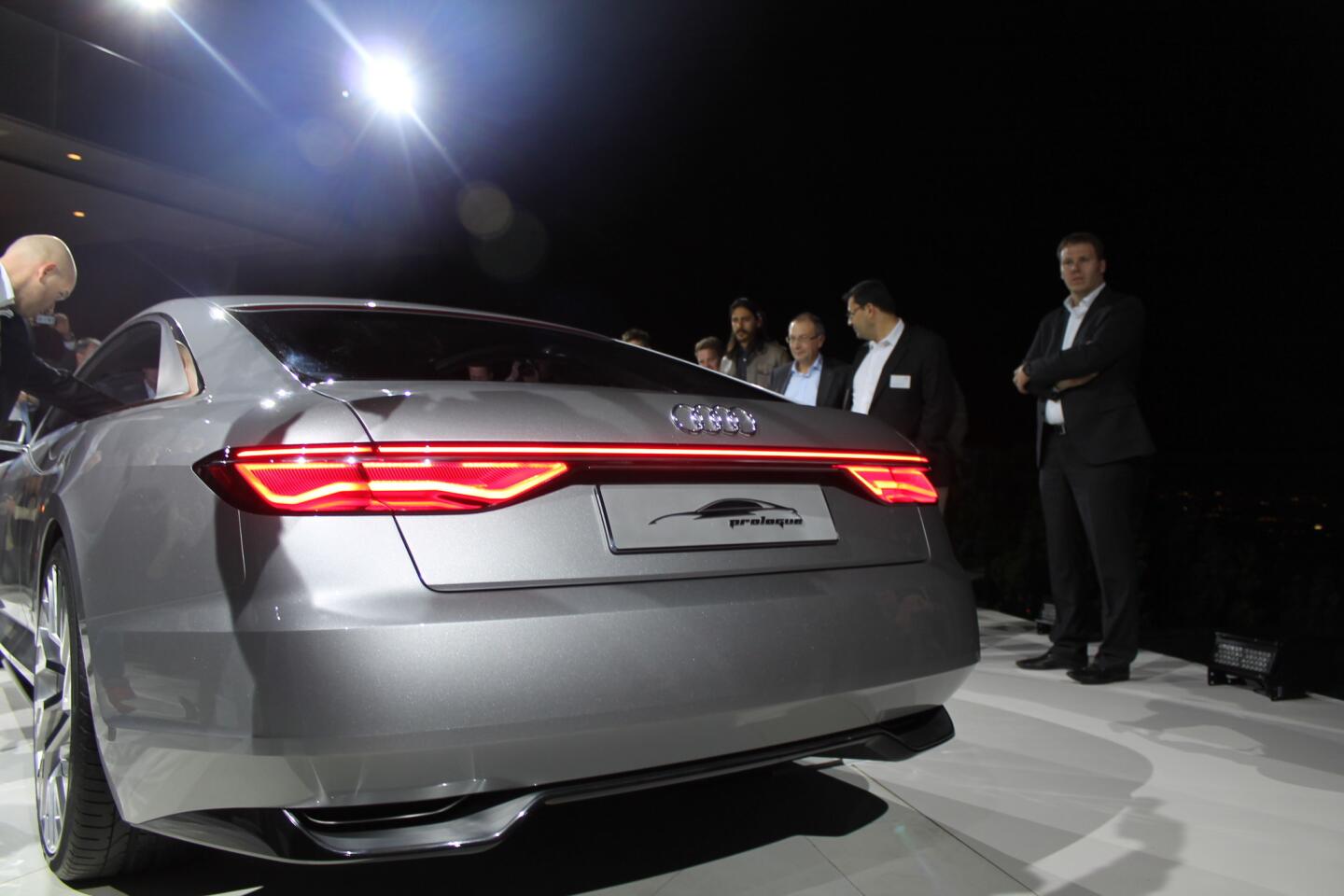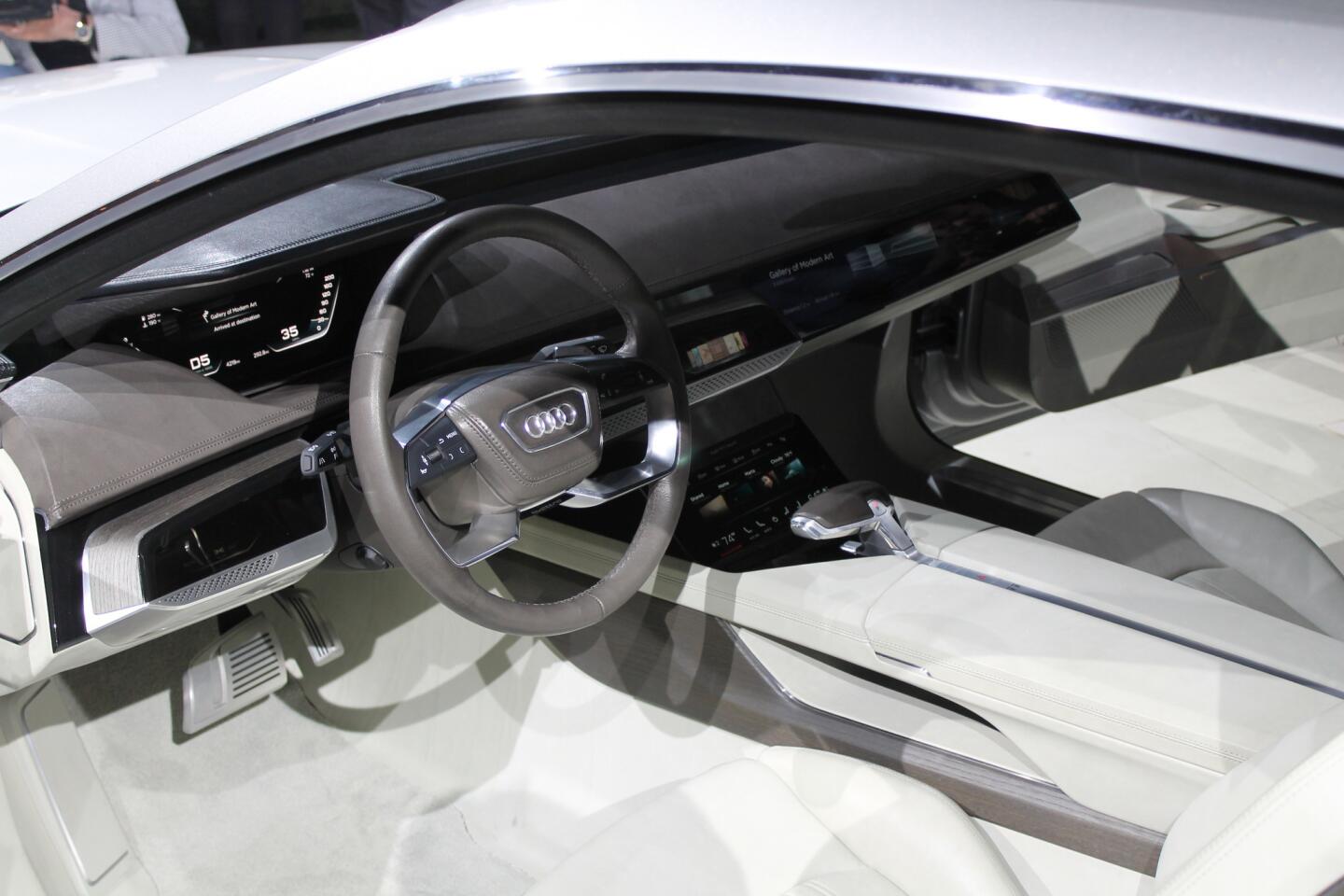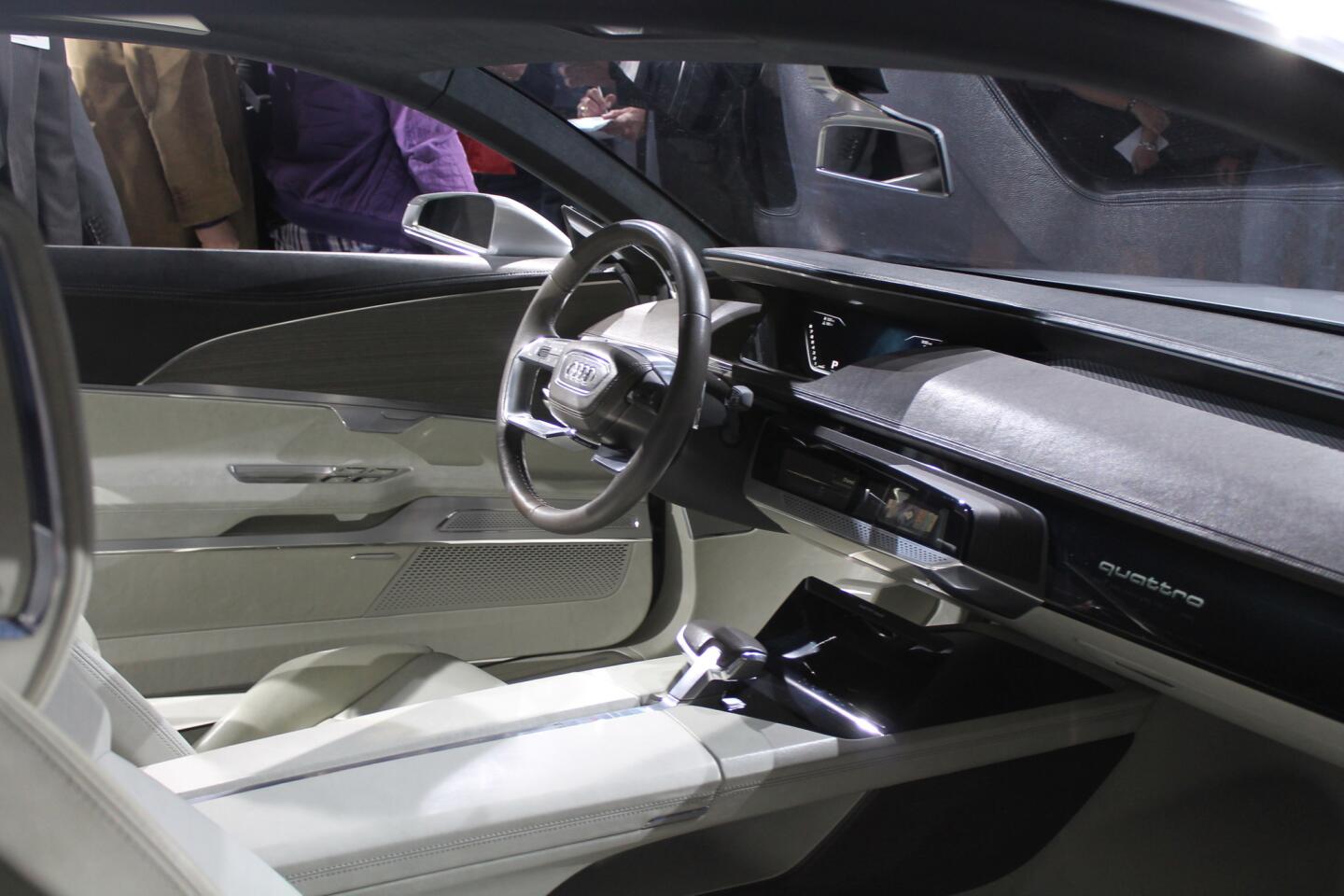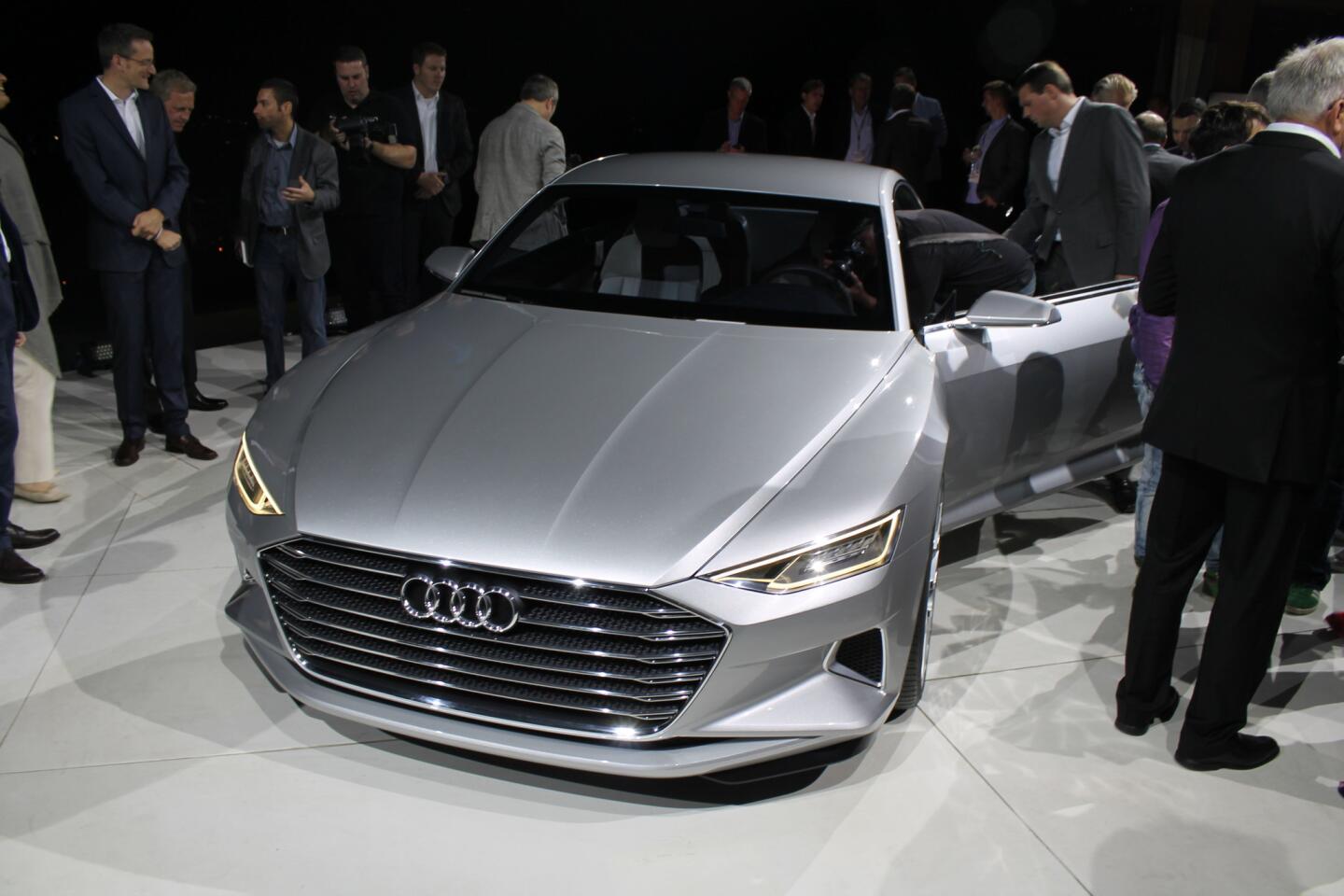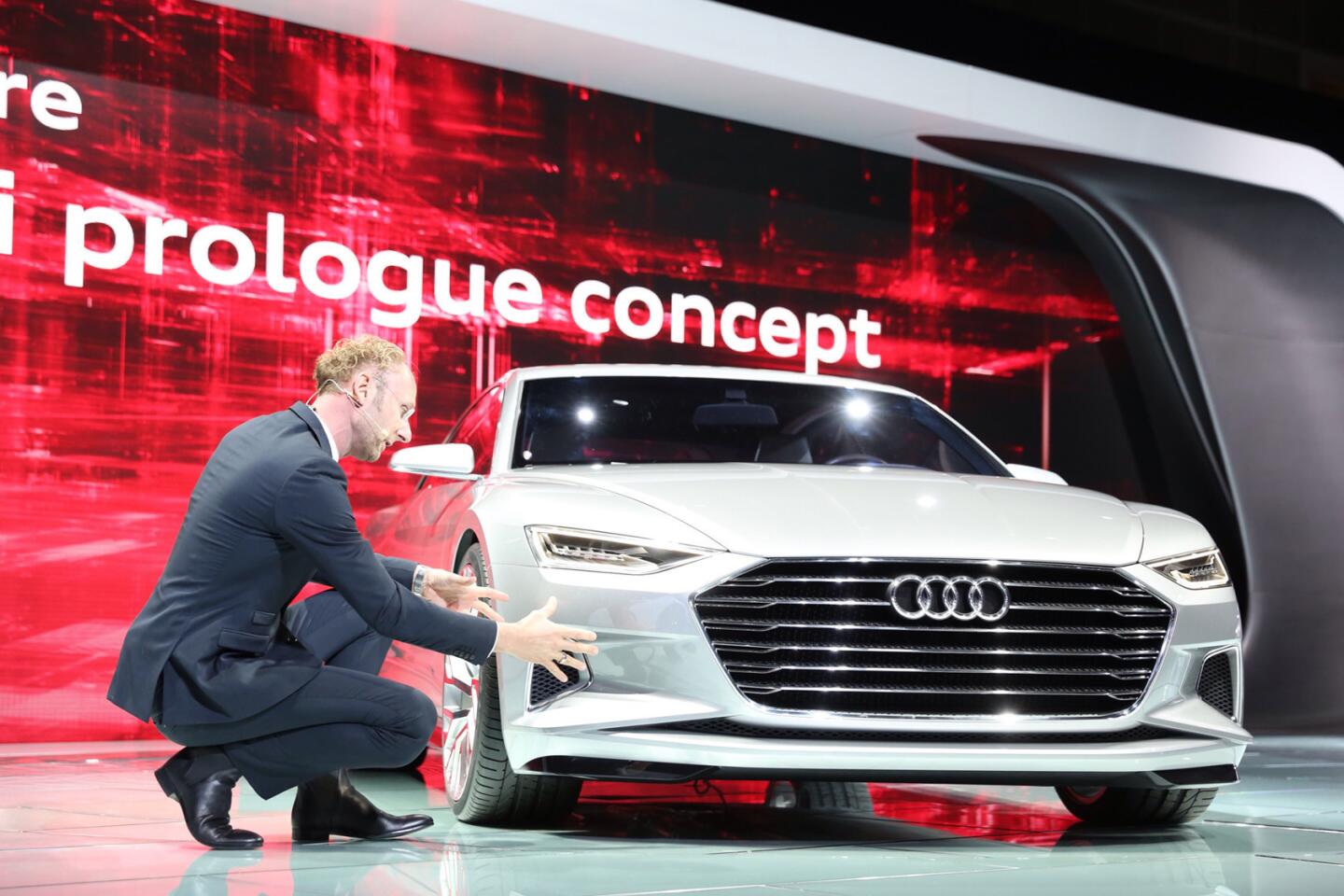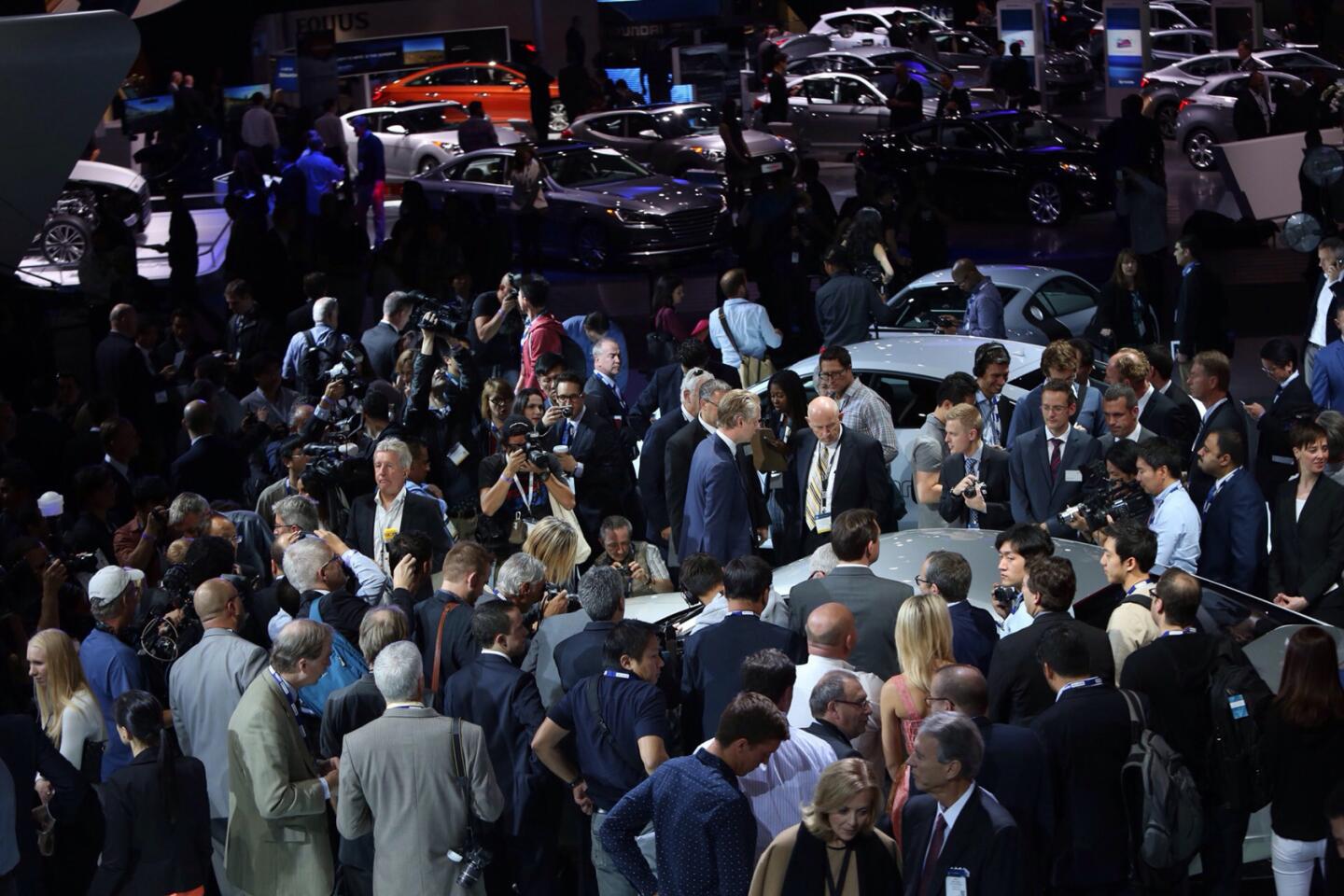Audi Prologue concept car foreshadows a sultry, luxurious future
Our German chaperone is nervous. Sitting in the passenger seat of Audi’s hand-built Prologue concept car that debuted last week at the L.A. Auto Show as we cruise through Beverly Hills, he eyes the police surrounding us.
“Slowly, slower,” he says politely as he squints into the tiny side-view mirror. We ease off the 605-horsepower throttle a bit, as the motorcycle cop behind us weaves across Burton Way.
It’s not the police our co-pilot is concerned about; they’re part of a mini motorcade keeping the Audi safe from errant drivers. He’s worried about the Prologue itself: a prototype that cost Audi between $4 million and $6 million to build.
Hand-built over seven weeks this fall, the glimmering full-size coupe is a rolling exhibition of Audi’s future. The design elements from the car’s interior and exterior will be incorporated into the next generation of Audi’s large cars, starting with the new Audi A8 sedan due for sale in 2017.
The midsize A6 and A7 will follow shortly after that. Audi is also expected to build a coupe very similar to this Prologue. Based on the A8, the car probably will be the first car to bear the A9 name in Audi’s history, and will take Mercedes-Benz’s S-Class Coupe head-on.
This is the first time the Audi prototype cruised down any city street. It’s the first time Audi’s new design chief, Marc Lichte, has seen the car on a real road. He’s in one of the two SUVs ahead of us in the motorcade, in front of another police unit.
Lichte sits cross-legged in the SUV’s wayback, facing backward and watching through the open liftgate as a photographer next to him chronicles the spectacle.
After our drive, the 44-year-old’s eyes twinkle as he describes what it’s like seeing his baby out of the design studio for the first time.
“The shoulders and the muscles are a lot more visible when you are outside,” Lichte said. “For me this is super-exciting because this is exactly what you work for.”
Audi appointed Lichte as its design chief last February; before that he was the head of exterior design at Volkswagen. Lichte and his team have a lot on their plate. Audi is in the process of splitting the design direction of its line of A sedans and Q SUVs, both of which will get complete makeovers over the next several years.
“In 2003 we started with a single frame grille, which was a bold statement for the brand,” Rupert Stadler, chairman of the board for Audi, said in an interview at the L.A. show. That helped Audi create a visual personality as identifiable as the ones BMW and Mercedes have spent decades establishing. “Now I think the time is mature to go that next step.”
Lichte started that next step last February with nearly a blank sheet of paper. He finished the work just a few weeks before coming to L.A., when Audi froze the designs for the three A sedans, which now move on to the engineering stage of production.
In the midst of scrambling to reinvent the face of Audi, Lichte was also tasked with creating the Prologue concept. While the company hasn’t officially confirmed it will build an A9 that the Prologue foreshadows, any mention of it around Audi execs is met with a wink and a nod. Bet on this car reaching production.
This concept car, according to the company, incorporates 80% to 90% of the production cars’ design cues, inside and out.
Key among the exterior cues is a massive flat grille that spans nearly the entire width of the car’s nose. It’s highlighted by six horizontal chrome bars and Audi’s four-rings logo prominently displayed in the middle. Thin trapezoidal headlights squint out from either side of it.
The coupe’s roofline descends slowly toward the rear of the car, leaving almost no flat trunk lid. This makes Prologue’s silhouette imposing and dramatic, and looking a smidge heavy.
At the back, LED taillights are horizontally oriented, including a thin strip of lights running the entire width of the back end. The taillights also have a sculpted three-dimensionality to them that’s hard to show in pictures.
The car’s fenders swell outward to cover each of the wheels, a deliberate move by Lichte to highlight Audi’s Quattro all-wheel-drive system in the same way a rear-wheel-drive Mercedes or BMW is often denoted by a long hood.
The overall look of the Prologue is less revolutionary and more of a healthy evolution. True to its production intent, the coupe looks at home on L.A.’s streets rather than looking like a Jetsons science experiment.
“I think this kind of car fits perfect in L.A.,” Lichte had said a few nights earlier as the concept was officially unveiled at the $18-million Hollywood home of the Winklevoss twins (think Facebook). It was always his team’s intention to unveil the Prologue in the City of Angels, Lichte said. “It’s a very expressive car; I think it fits [in L.A.]. And I like this place. This is an area which inspires.”
The Jetsons stuff is inside the car.
Using the same horizontally oriented theme as on the exterior, several touch-sensitive screens stretch across the dashboard for both the driver and passenger.
Audi also worked with Samsung to develop a cutting-edge OLED flexible glass screen that curves out of the center console just ahead of the shifter. Flexible display screens like this are at the infancy of their development, though manufacturers like LG and Samsung hope to have production screens on the market around the same time as Audi’s next A8 in 2017. They’ll be expensive.
The driver’s instrument panel on the Prologue is a 3-D digital screen, an elaborate evolution of the wide-screen display Audi recently introduced on its 2016 TT compact sports car. And although Audi is aware that these prototype elements inside the Prologue may seem farfetched, the company says it’s determined to be out front on in-car electronics.
“There is a different speed in the consumer electronics world, and I think we and our engineers have to be aware of that,” Stadler said. “Audi is progressive and progressive means that we are looking towards the future as fast as possible.”
The rarity of such flexible glass screens is one of the reasons the Prologue cost Audi millions to build. (The automaker wouldn’t reveal the specific figure.) Yet the production car would cost a fraction of that, with the A9 coupe ringing in around the $100,000 to $120,000 mark once Audi confirms it and sells it.
The concept is also pricey thanks to the carbon fiber body panels, the aluminum trim inside and out, and the wood and leather throughout the interior. It’s like a couture dress: a one-off piece made, finished and assembled by hand without the economies of scale to drive the price down.
It took a team of 20 people seven weeks working around the clock to build, Audi said. The chassis underneath is a shortened version of what’s on the next-generation A8. To power the thing, Audi grabbed a 4.0-liter twin-turbocharged V-8 out of its RS7 and kicked power up a notch. It now cranks out 605 horsepower and 553 pound-feet of torque.
Before we’re allowed to drive it, Audi’s minders have us don a disposable plastic painter’s suit and booties, so as to keep the creamy white leather in perfect condition. True to its concept form, there are no door handles on this coupe; wave your hand over the door sill and it pops open automatically.
A push of the aluminum starter button by the shifter fires up the massive engine in front of us. We tap the shift lever — also touch-sensitive — to put the car in gear. Our minder gives a wave to the cops, who pull out of the parking lot with a blip of their lights and siren, and our mini future-parade is on its way.
The drive is more a low-speed demonstration than an outright test. No one wants a crashed prototype worth millions on his resume. And the massive amount of heat generated by the bleeding-edge electronics causes the engine’s computers to retard full acceleration anyway.
But despite its kit-car status, the Prologue concept drives like the sultry coupe that it hopes to be. The suspension is cushy, the steering is direct, and the power — when it’s available — is immense. The car’s mass and proportions are perfect for the boulevard cruising that our 30-minute drive takes us on, weaving through and around Beverly Hills.
But it’s people’s reactions that bode well for this coupe’s future. The police escort almost seems unnecessary; this car stops traffic on its own. L.A. may be a disenchanted audience for new or rare cars, but the Audi Prologue grabs attention — cellphones, stares, pointing — easily.
As our escorts slow to a crawl waiting for an intersection to clear up, two men who look like potential A9 owners notice the car and walk up to it, clearly trying to figure out what they’re seeing. One whips out his iPhone to snap a picture of the interior.
“What kind of Audi is this?” his friend asks. Our chaperone smiles as the motorcade starts moving again, and says cryptically out the window, “The future kind.”
david.undercoffler@latimes.com
Twitter: @latimes_driven
